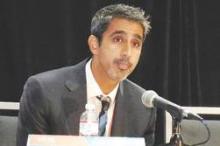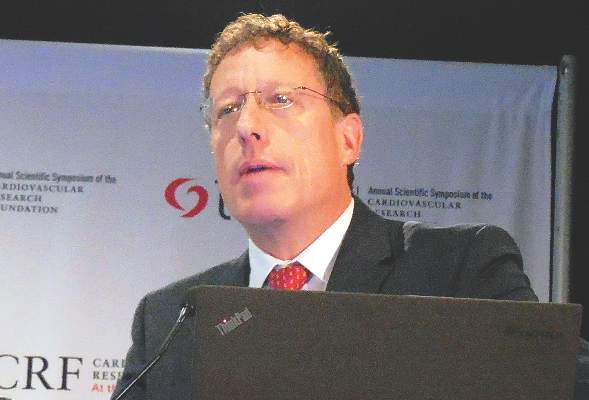User login
SAN FRANCISCO – The antianginal drug ranolazine proved safe but completely ineffective at heading off new, severe anginal episodes when used prophylactically in patients who had recently undergone an incomplete revascularization in a prospective trial with more than 2,600 randomized patients.
While the trial failed to identify a new treatment to help these patients, it succeeded in better defining and documenting an at-risk population that could use a new, effective treatment of some kind: patients who have recently undergone incomplete revascularization.
The RIVER-PCI (Ranolazine for Incomplete Vessel Revascularization Post-Percutaneous Coronary Intervention) trial prospectively followed a large group of these patients with just one other qualification: They had to have also experienced at least two anginal episodes during the prior 1-12 months (angina within 30 days of the PCI didn’t count). The study results showed that during an average 1.8 years of follow-up, these patients had a 27% rate of ischemic, anginal episodes severe enough to push them to either hospitalization or another round of revascularization, Dr. Giora Weisz reported at the Transcatheter Cardiovascular Therapeutics annual meeting.
“This event rate is very high. I want to better treat and do something more for these patients” with incomplete revascularization, “So we still need to look for an answer, to look for other options that might improve their outcomes,” said Dr. Weisz, professor and director of cardiology at the Jerusalem Heart Center of Shaare Zedek Medical Center.
Incomplete revascularization – defined in the study as coronary stenoses visible on an angiogram that block at least 50% of a coronary artery that is at least 2 mm in diameter – occurs quite often, Dr. Weisz noted. These significant stenoses exist in roughly half the patients who undergo PCI and in some instances in as many as 80%. These lesions usually go untreated because they seem clinically unimportant at the time of the index procedure, he explained.
“We need to better understand why the prognosis is so bad” in incompletely revascularized patients. “We need to better understand which lesions are the ones that produce poor outcomes and how we can better treat them both pharmacologically and with interventions,” commented Dr. Stefan James, a professor of cardiology at Uppsala (Sweden) University.
The findings also highlighted the limitations of ranolazine (Ranexa) as a treatment for angina and cardiac ischemia, although Dr. Weisz and others remained convinced that it is an effective drug for reducing angina in other situations, specifically patients with recurring episodes of severe angina.
Ranolazine “did not prevent ischemia, but it remains useful for patients with refractory angina; that is a separate indication,” commented Dr. Sanjit S. Jolly of McMaster University, Hamilton, Ont.
Dr. Weisz speculated that one explanation for ranolazine’s lack of efficacy is that the drug doesn’t prevent ischemia and angina directly but rather interrupts the self-exacerbating cycle of angina. The ischemia that produces angina activates “late sodium” channels in myocardial cells, which boosts intracellular calcium levels and increases oxygen demand in cells while also dropping intracellular oxygen supply, thereby triggering further worsening of the ischemia, he explained. “Ischemia aggravates itself, and ranolazine prevents this by blocking the late sodium channels,” but clearly this effect did not prevent new anginal episodes in patients who experienced incomplete revascularization, he said in an interview.
Dr. Weisz and his associates ran RIVER-PCI during November 2011–May 2013 at 245 sites in 15 countries. They randomized and followed 1,317 patients who received 1,000 mg ranolazine twice daily and 1,287 placebo patients. All patients also received all the other medications appropriate for post-PCI patients, including aspirin and another antiplatelet drug, a statin, a beta-blocker, renin-angiotensin-aldosterone system blocking drugs, as well as other blood pressure lowering and vasodilating medications.
During an average follow-up of 1.8 years, patients in the ranolazine arm had a 26% incidence of ischemia-driven hospitalization of revascularization, and patients in the control arm had a 28% rate, a between-group difference that was not statistically significant. Ranolazine treatment had no significant benefit over placebo for any secondary efficacy measure, but it was also safe and generally well tolerated. About 40% of patients in the ranolazine arm and 36% in the placebo arm discontinued their study treatment during the course of follow-up. Concurrent with Dr. Weisz’s report the results also appeared in an article published online (Lancet 2015 Oct 13;doi: 10.1016/S0140-6736[15]00459-6).
During his report of the findings, Dr. Weisz defended the endpoint used in the study, ischemia-driven hospitalization or revascularization, which he conceded could be considered a “soft” endpoint.
“We had a very strict definition of these events, and every episode was reviewed by an independent committee that judged whether or not to include the event. Every patient with an ischemia-driven event had to show characteristic symptoms and objective evidence of ischemia such as an ECG change or elevated enzymes. We tried to approach judging patient symptoms as scientifically as possible,” he said.
On Twitter @mitchelzoler
The adjunctive treatment of patients who undergo incomplete revascularization is a real unmet need. The results from the RIVER-PCI trial showed that about 27% of patients who undergo an incomplete revascularization with percutaneous coronary intervention have a major ischemia-driven event within the next 2 years. In RIVER-PCI, we were unable to prevent these events by giving patients the anti-ischemia drug ranolazine.
In the study, the rates of new MIs and cardiovascular mortality were relatively low. It was recurrent ischemic events that drove the outcome we saw. If nothing else, this study has opened a new avenue for research into this high-risk group of patients.
 |
| Mitchel L. Zoler/Frontline Medical News Dr. Gregg W. Stone |
As interventional cardiologists, we don’t usually think about the coronary disease that we leave behind following a revascularization procedure. Patients who undergo incomplete revascularization may avoid having an excess of future MIs or death, but they still experience a lot of angina, which leads to rehospitalizations and new procedures. I think we could improve the quality of life for our patients if we can come up with new ways to improve revascularization procedures and better approaches to preventing ischemia and angina following these procedures.
Dr. Gregg W. Stone was chairman of the RIVER-PCI trial and is professor and director of cardiovascular research and education at the Center for Interventional Vascular Therapy at Columbia University in New York. He has been a consultant to nine companies but has no relationship with Gilead Sciences and the Menarini Group, the two companies that sponsored the trial and that market ranolazine. He made these comments during the session that discussed the RIVER-PCI results.
The adjunctive treatment of patients who undergo incomplete revascularization is a real unmet need. The results from the RIVER-PCI trial showed that about 27% of patients who undergo an incomplete revascularization with percutaneous coronary intervention have a major ischemia-driven event within the next 2 years. In RIVER-PCI, we were unable to prevent these events by giving patients the anti-ischemia drug ranolazine.
In the study, the rates of new MIs and cardiovascular mortality were relatively low. It was recurrent ischemic events that drove the outcome we saw. If nothing else, this study has opened a new avenue for research into this high-risk group of patients.
 |
| Mitchel L. Zoler/Frontline Medical News Dr. Gregg W. Stone |
As interventional cardiologists, we don’t usually think about the coronary disease that we leave behind following a revascularization procedure. Patients who undergo incomplete revascularization may avoid having an excess of future MIs or death, but they still experience a lot of angina, which leads to rehospitalizations and new procedures. I think we could improve the quality of life for our patients if we can come up with new ways to improve revascularization procedures and better approaches to preventing ischemia and angina following these procedures.
Dr. Gregg W. Stone was chairman of the RIVER-PCI trial and is professor and director of cardiovascular research and education at the Center for Interventional Vascular Therapy at Columbia University in New York. He has been a consultant to nine companies but has no relationship with Gilead Sciences and the Menarini Group, the two companies that sponsored the trial and that market ranolazine. He made these comments during the session that discussed the RIVER-PCI results.
The adjunctive treatment of patients who undergo incomplete revascularization is a real unmet need. The results from the RIVER-PCI trial showed that about 27% of patients who undergo an incomplete revascularization with percutaneous coronary intervention have a major ischemia-driven event within the next 2 years. In RIVER-PCI, we were unable to prevent these events by giving patients the anti-ischemia drug ranolazine.
In the study, the rates of new MIs and cardiovascular mortality were relatively low. It was recurrent ischemic events that drove the outcome we saw. If nothing else, this study has opened a new avenue for research into this high-risk group of patients.
 |
| Mitchel L. Zoler/Frontline Medical News Dr. Gregg W. Stone |
As interventional cardiologists, we don’t usually think about the coronary disease that we leave behind following a revascularization procedure. Patients who undergo incomplete revascularization may avoid having an excess of future MIs or death, but they still experience a lot of angina, which leads to rehospitalizations and new procedures. I think we could improve the quality of life for our patients if we can come up with new ways to improve revascularization procedures and better approaches to preventing ischemia and angina following these procedures.
Dr. Gregg W. Stone was chairman of the RIVER-PCI trial and is professor and director of cardiovascular research and education at the Center for Interventional Vascular Therapy at Columbia University in New York. He has been a consultant to nine companies but has no relationship with Gilead Sciences and the Menarini Group, the two companies that sponsored the trial and that market ranolazine. He made these comments during the session that discussed the RIVER-PCI results.
SAN FRANCISCO – The antianginal drug ranolazine proved safe but completely ineffective at heading off new, severe anginal episodes when used prophylactically in patients who had recently undergone an incomplete revascularization in a prospective trial with more than 2,600 randomized patients.
While the trial failed to identify a new treatment to help these patients, it succeeded in better defining and documenting an at-risk population that could use a new, effective treatment of some kind: patients who have recently undergone incomplete revascularization.
The RIVER-PCI (Ranolazine for Incomplete Vessel Revascularization Post-Percutaneous Coronary Intervention) trial prospectively followed a large group of these patients with just one other qualification: They had to have also experienced at least two anginal episodes during the prior 1-12 months (angina within 30 days of the PCI didn’t count). The study results showed that during an average 1.8 years of follow-up, these patients had a 27% rate of ischemic, anginal episodes severe enough to push them to either hospitalization or another round of revascularization, Dr. Giora Weisz reported at the Transcatheter Cardiovascular Therapeutics annual meeting.
“This event rate is very high. I want to better treat and do something more for these patients” with incomplete revascularization, “So we still need to look for an answer, to look for other options that might improve their outcomes,” said Dr. Weisz, professor and director of cardiology at the Jerusalem Heart Center of Shaare Zedek Medical Center.
Incomplete revascularization – defined in the study as coronary stenoses visible on an angiogram that block at least 50% of a coronary artery that is at least 2 mm in diameter – occurs quite often, Dr. Weisz noted. These significant stenoses exist in roughly half the patients who undergo PCI and in some instances in as many as 80%. These lesions usually go untreated because they seem clinically unimportant at the time of the index procedure, he explained.
“We need to better understand why the prognosis is so bad” in incompletely revascularized patients. “We need to better understand which lesions are the ones that produce poor outcomes and how we can better treat them both pharmacologically and with interventions,” commented Dr. Stefan James, a professor of cardiology at Uppsala (Sweden) University.
The findings also highlighted the limitations of ranolazine (Ranexa) as a treatment for angina and cardiac ischemia, although Dr. Weisz and others remained convinced that it is an effective drug for reducing angina in other situations, specifically patients with recurring episodes of severe angina.
Ranolazine “did not prevent ischemia, but it remains useful for patients with refractory angina; that is a separate indication,” commented Dr. Sanjit S. Jolly of McMaster University, Hamilton, Ont.
Dr. Weisz speculated that one explanation for ranolazine’s lack of efficacy is that the drug doesn’t prevent ischemia and angina directly but rather interrupts the self-exacerbating cycle of angina. The ischemia that produces angina activates “late sodium” channels in myocardial cells, which boosts intracellular calcium levels and increases oxygen demand in cells while also dropping intracellular oxygen supply, thereby triggering further worsening of the ischemia, he explained. “Ischemia aggravates itself, and ranolazine prevents this by blocking the late sodium channels,” but clearly this effect did not prevent new anginal episodes in patients who experienced incomplete revascularization, he said in an interview.
Dr. Weisz and his associates ran RIVER-PCI during November 2011–May 2013 at 245 sites in 15 countries. They randomized and followed 1,317 patients who received 1,000 mg ranolazine twice daily and 1,287 placebo patients. All patients also received all the other medications appropriate for post-PCI patients, including aspirin and another antiplatelet drug, a statin, a beta-blocker, renin-angiotensin-aldosterone system blocking drugs, as well as other blood pressure lowering and vasodilating medications.
During an average follow-up of 1.8 years, patients in the ranolazine arm had a 26% incidence of ischemia-driven hospitalization of revascularization, and patients in the control arm had a 28% rate, a between-group difference that was not statistically significant. Ranolazine treatment had no significant benefit over placebo for any secondary efficacy measure, but it was also safe and generally well tolerated. About 40% of patients in the ranolazine arm and 36% in the placebo arm discontinued their study treatment during the course of follow-up. Concurrent with Dr. Weisz’s report the results also appeared in an article published online (Lancet 2015 Oct 13;doi: 10.1016/S0140-6736[15]00459-6).
During his report of the findings, Dr. Weisz defended the endpoint used in the study, ischemia-driven hospitalization or revascularization, which he conceded could be considered a “soft” endpoint.
“We had a very strict definition of these events, and every episode was reviewed by an independent committee that judged whether or not to include the event. Every patient with an ischemia-driven event had to show characteristic symptoms and objective evidence of ischemia such as an ECG change or elevated enzymes. We tried to approach judging patient symptoms as scientifically as possible,” he said.
On Twitter @mitchelzoler
SAN FRANCISCO – The antianginal drug ranolazine proved safe but completely ineffective at heading off new, severe anginal episodes when used prophylactically in patients who had recently undergone an incomplete revascularization in a prospective trial with more than 2,600 randomized patients.
While the trial failed to identify a new treatment to help these patients, it succeeded in better defining and documenting an at-risk population that could use a new, effective treatment of some kind: patients who have recently undergone incomplete revascularization.
The RIVER-PCI (Ranolazine for Incomplete Vessel Revascularization Post-Percutaneous Coronary Intervention) trial prospectively followed a large group of these patients with just one other qualification: They had to have also experienced at least two anginal episodes during the prior 1-12 months (angina within 30 days of the PCI didn’t count). The study results showed that during an average 1.8 years of follow-up, these patients had a 27% rate of ischemic, anginal episodes severe enough to push them to either hospitalization or another round of revascularization, Dr. Giora Weisz reported at the Transcatheter Cardiovascular Therapeutics annual meeting.
“This event rate is very high. I want to better treat and do something more for these patients” with incomplete revascularization, “So we still need to look for an answer, to look for other options that might improve their outcomes,” said Dr. Weisz, professor and director of cardiology at the Jerusalem Heart Center of Shaare Zedek Medical Center.
Incomplete revascularization – defined in the study as coronary stenoses visible on an angiogram that block at least 50% of a coronary artery that is at least 2 mm in diameter – occurs quite often, Dr. Weisz noted. These significant stenoses exist in roughly half the patients who undergo PCI and in some instances in as many as 80%. These lesions usually go untreated because they seem clinically unimportant at the time of the index procedure, he explained.
“We need to better understand why the prognosis is so bad” in incompletely revascularized patients. “We need to better understand which lesions are the ones that produce poor outcomes and how we can better treat them both pharmacologically and with interventions,” commented Dr. Stefan James, a professor of cardiology at Uppsala (Sweden) University.
The findings also highlighted the limitations of ranolazine (Ranexa) as a treatment for angina and cardiac ischemia, although Dr. Weisz and others remained convinced that it is an effective drug for reducing angina in other situations, specifically patients with recurring episodes of severe angina.
Ranolazine “did not prevent ischemia, but it remains useful for patients with refractory angina; that is a separate indication,” commented Dr. Sanjit S. Jolly of McMaster University, Hamilton, Ont.
Dr. Weisz speculated that one explanation for ranolazine’s lack of efficacy is that the drug doesn’t prevent ischemia and angina directly but rather interrupts the self-exacerbating cycle of angina. The ischemia that produces angina activates “late sodium” channels in myocardial cells, which boosts intracellular calcium levels and increases oxygen demand in cells while also dropping intracellular oxygen supply, thereby triggering further worsening of the ischemia, he explained. “Ischemia aggravates itself, and ranolazine prevents this by blocking the late sodium channels,” but clearly this effect did not prevent new anginal episodes in patients who experienced incomplete revascularization, he said in an interview.
Dr. Weisz and his associates ran RIVER-PCI during November 2011–May 2013 at 245 sites in 15 countries. They randomized and followed 1,317 patients who received 1,000 mg ranolazine twice daily and 1,287 placebo patients. All patients also received all the other medications appropriate for post-PCI patients, including aspirin and another antiplatelet drug, a statin, a beta-blocker, renin-angiotensin-aldosterone system blocking drugs, as well as other blood pressure lowering and vasodilating medications.
During an average follow-up of 1.8 years, patients in the ranolazine arm had a 26% incidence of ischemia-driven hospitalization of revascularization, and patients in the control arm had a 28% rate, a between-group difference that was not statistically significant. Ranolazine treatment had no significant benefit over placebo for any secondary efficacy measure, but it was also safe and generally well tolerated. About 40% of patients in the ranolazine arm and 36% in the placebo arm discontinued their study treatment during the course of follow-up. Concurrent with Dr. Weisz’s report the results also appeared in an article published online (Lancet 2015 Oct 13;doi: 10.1016/S0140-6736[15]00459-6).
During his report of the findings, Dr. Weisz defended the endpoint used in the study, ischemia-driven hospitalization or revascularization, which he conceded could be considered a “soft” endpoint.
“We had a very strict definition of these events, and every episode was reviewed by an independent committee that judged whether or not to include the event. Every patient with an ischemia-driven event had to show characteristic symptoms and objective evidence of ischemia such as an ECG change or elevated enzymes. We tried to approach judging patient symptoms as scientifically as possible,” he said.
On Twitter @mitchelzoler
AT TCT 2015
Key clinical point: Prophylactic ranolazine failed to stop major episodes of angina in patients who had undergone incomplete coronary revascularization.
Major finding: Ischemia-driven hospitalizations or revascularizations occurred in 26% of patients on ranolazine and 28% of patients on placebo.
Data source: RIVER-PCI, a prospective, multicenter, randomized trial with 2,604 patients treated and followed for an average of 1.8 years.
Disclosures: RIVER-PCI was sponsored by Gilead Sciences and the Menarini Group, the companies that market ranolazine (Ranexa). Dr. Weisz said that he had no relevant disclosures. Dr. James has received honoraria from AstraZeneca, the Medicines Company, and Sanofi-Aventis. Dr. Jolly had no relevant disclosures.



